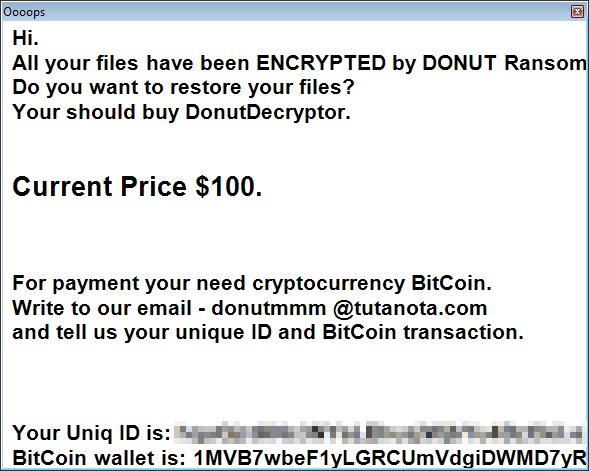
An infection with the dangerous Donut ransomware virus leads to serious security issues. Victims can restore and protect their computers by following our complete removal guide.
Manual Removal Guide
Recover .donut Files
Skip all steps and download anti-malware tool that will safely scan and clean your PC.
SpyHunter anti-malware tool will diagnose all current threats on the computer. By purchasing the full version, you will be able to remove all malware threats instantly. Additional information about SpyHunter / Help to uninstall SpyHunter
Distribution of Donut Ransomware Virus
Donut virus is a new data locker ransomware that has been released in attack campaigns against computer users worldwide. The threat could be utilizing widely used tactics of distribution to infect computer systems.
One of the easiest ways for the criminals to spread the payload of Donut ransomware is by attaching it to email messages that are later released in active attack campaigns. The method allows hackers to send the virus to large lists of potential victims. The attachments to malicious email spam messages usually have Word documents or other types of files which users open without hesitation. Once opened on a target host these compromised files trigger the ransomware payload and infect the device with Donut crypto virus. Another infection tactic related to emails is hyperlink inserted in the content of the messages. The links are usually labeled as leading to a familiar website or a file of user interest.
Computer criminals behind this new ransomware can be using malicious sites or download portals to distribute malware of different kinds, including Donut virus. A popular option is the use of infected documents which may be of different types ‒ spreadsheets, rich text documents, presentations and databases. They are modified to initiate the virus once the built-in scripts are run. Usually when the files are opened a notification will ask the users to run the macros (scripts). If this is done the infection follows.
The hacker-controlled sites are specialist portals that have been created either manually or automatically by the criminals behind Donut virus. They can either directly distribute the threat by initiating various scripts or automated operations or link to such instances. Redirects are usually caused by email interaction, ad networks or other browsing activity. However one of the main sources is the availability of browser hijackers. They are malicious add-ons made for the most popular web browsers ‒ Mozilla Firefox, Google Chrome, Internet Explorer, Opera, Microsoft Edge and Safari. Once installed they not only infect the users with the malware but also redirect the victims to a hacker-controlled site. Depending on the configuration the browser hijackers can also steal sensitive information such as any stored passwords, account credentials, history, bookmarks, form data and settings.
Impact of Donut Ransomware Virus
Donut is the name given to a data locker ransomware that was detected in the wild by the security researcher with nickname S!Ri. The analysis of Donut samples reveal that its code is based on HiddenTear – an open source ransomware initially released for educational purposes.
Even though, the code of HiddenTear ransomware was cracked at this point a free decryption solution for Donut lacks. This is due to the fact that hackers have implemented some modifications to transform the source code and prevent an easy decryption.
In case of infection with Donut ransomware virus your important files are encoded with strong cipher algorithm. After encryption your access to the information stored by corrupted files is restricted. Encrypted files could be recognized by the extension .donut that stands at the end of their names. For example if you have a file named memory.docx Donut ransomware virus will rename it to memory.docx.donut. The same goes to all types of files set as targets for encryption. It is likely that the crypto virus targets files that store sensitive information in order to confuse you and make you more prone to pay hackers the demanded ransom.
Unfortunately, Donut ransomware virus not only encrypts your sensitive data but also plagues some essential system settings during the attack. So before it reaches the data encryption stage, it is likely to establish and run needed malicious files. Some of these files are supposedly designed to access the Registry Editor and plague settings of some keys stored there.
At the ends of the infection process the crypto virus will replace your desktop wallpaper with the ransom message it generates. In addition, a pink donut is likely to circle at the bottom of your PC screen. The message is stored in a file called decrypt.txt and all it reads is:
Hi.
All your files have been ENCRYPTED by DONUT Ransomware
Do you want to restore your files?
Your should buy DonutDecryptor.
Current Price $100.
For payment your need cryptocurrency BitCoin.
Write to our email – donutmmm @tutanota.com
and tell us your unique ID and BitCoin transaction.
Your Uniq ID is: *****
BitCoin wallet is: 1MVB7wbeF1yLGRCUmVdgiDWMD7yR

What hackers demand is an amount of $100 to be converted in Bitcoin cryptocurrency and transferred to their wallet address. However, there is no guarantee that they will be so nice to respond you and send you the decryption key. Furthermore, this key may not be working as sometimes even a single mistake in the code could lead to the generation of broken decryption key. So instead of paying the ransom for the decryption keys possessed by hackers try to recover .donut files with alternative data recovery solutions. When you reach the guide at the end of the article you will find some suggestions made by our team. They could help you to restore few to all of the .donut files.
Remove Donut Ransomware Virus and Restore PC
Please note that paying the requested ransom fee to cyber criminals does not really solve your problem with Donut crypto virus. In fact, you only encourage hackers to continue spreading ransomware of this kind. Instead, you must remove the threat immediately, and only then look for optional ways to recover your data.
WARNING! Manual removal of Donut ransomware virus requires being familiar with system files and registries. Removing important data accidentally can lead to permanent system damage. If you don’t feel comfortable with manual instructions, download a powerful anti-malware tool that will scan your system for malware and clean it safely for you.
DOWNLOAD Anti-Malware ToolDonut Ransomware Virus – Manual Removal Steps
Start the PC in Safe Mode with Network
This will isolate all files and objects created by the ransomware so they will be removed efficiently. The steps below are applicable to all Windows versions.
1. Hit the WIN Key + R
2. A Run window will appear. In it, write msconfig and then press Enter
3. A Configuration box shall appear. In it Choose the tab named Boot
4. Mark Safe Boot option and then go to Network under it to tick it too
5. Apply -> OK
Show Hidden Files
Some ransomware threats are designed to hide their malicious files in the Windows so all files stored on the system should be visible.
1. Open My Computer/This PC
2. Windows 7
-
– Click on Organize button
– Select Folder and search options
– Select the View tab
– Go under Hidden files and folders and mark Show hidden files and folders option
3. Windows 8/ 10
-
– Open View tab
– Mark Hidden items option

4. Click Apply and then OK button
Enter Windows Task Manager and Stop Malicious Processes
1. Hit the following key combination: CTRL+SHIFT+ESC
2. Get over to Processes
3. When you find suspicious process right click on it and select Open File Location
4. Go back to Task Manager and end the malicious process. Right click on it again and choose End Process
5. Next, you should go folder where the malicious file is located and delete it
Repair Windows Registry
1. Again type simultaneously the WIN Key + R key combination
2. In the box, write regedit and hit Enter
3. Type the CTRL+ F and then write the malicious name in the search type field to locate the malicious executable
4. In case you have discovered registry keys and values related to the name, you should delete them, but be careful not to delete legitimate keys
Click for more information about Windows Registry and further repair help
Recover .donut Files
WARNING! All files and objects associated with Donut ransomware virus should be removed from the infected PC before any data recovery attempts. Otherwise the virus may encrypt restored files. Furthermore, a backup of all encrypted files stored on external media is highly recommendable.
SpyHunter anti-malware tool will diagnose all current threats on the computer. By purchasing the full version, you will be able to remove all malware threats instantly. Additional information about SpyHunter / Help to uninstall SpyHunter
1. Use present backups
2. Use professional data recovery software
Stellar Phoenix Data Recovery – a specialist tool that can restore partitions, data, documents, photos, and 300 more file types lost during various types of incidents and corruption.
3. Using System Restore Point
-
– Hit WIN Key
– Select “Open System Restore” and follow the steps

4. Restore your personal files using File History
-
– Hit WIN Key
– Type restore your files in the search box
– Select Restore your files with File History
– Choose a folder or type the name of the file in the search bar
– Hit the “Restore” button



